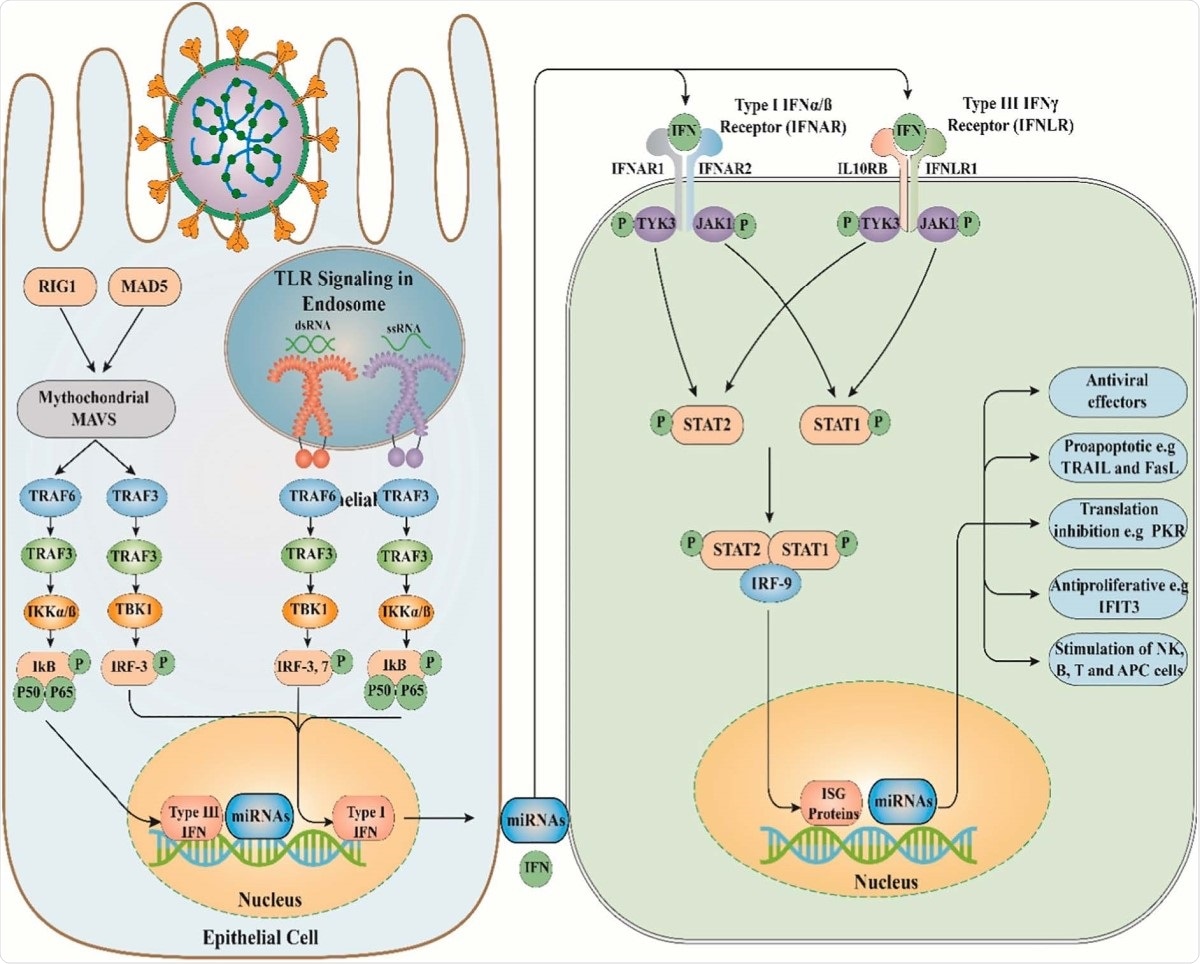The coronavirus disease 2019 (COVID-19) pandemic caused by the severe acute respiratory syndrome coronavirus 2 (SARS-CoV-2) has infected over 59.69 million people worldwide and has led to the deaths of over 1.4 million. The virus was first detected in late-2019 in Wuhan, China, and has since spread across the globe to 191 countries.
Over the past eleven months, much has been discovered about the novel virus; its capacity to infect human host cells, its varying effects on infected individuals and the dynamics of its transmission from one person to another.
Now, a team of researchers based in Iran have explored the role of micro-RNA in COVID-19. Their study titled, “The emerging role of microRNAs in the severe acute respiratory syndrome coronavirus 2 (SARS-CoV-2) infection,” was published in the latest issue of the journal International Immunopharmacology.
SARS-CoV-2 is a betacoronavirus, which is an enveloped virus with a positive-sense single-stranded RNA. It belongs to the coronaviridae family, and like others of its kind, typically causes a respiratory tract infection (RTI).
Micro-RNAs
Micro-RNAs or miRNAs are essentially small molecules about 17 and 24 nucleotides in length. These are non-coding, single-stranded RNAs that are needed for the translation of mature messenger RNAs (mRNAs) into proteins.

The researchers write that these miRNAs play a role in various processes such as “cell propagation, differentiation, growth, and apoptosis.” These miRNAs also regulate the innate and adaptive immune systems.
Earlier studies have shown that the expression of these miRNAs can play a role in the host’s response to coronaviruses and other respiratory viruses. Changes in miRNA expressions within the epithelial cells of the host can contribute to “the pathogenesis of both severe and chronic respiratory infections,” the team writes.
This review looked at the role played by these miRNAs as available from scientific evidence.
SARS-CoV-2 and the resulting immune responses
When exposed to an infection such as the SARS-CoV-2, humoral immunity is activated. The T cells and B cells differentiate into plasma cells that produce antibodies (Abs) against the particular viral antigen (Ag). These Abs then stop the virus from entering the host cells.
The B and T cells produce Abs against the SARS-CoV-2’s “spike (S), nucleocapsid (N), membrane (M), and envelope (E) proteins (structural proteins).” The researchers write that the T helper 1 (Th1) response is important for control of both MERS-CoV and SARS-CoV-1 – other coronaviruses in the same family as SARS-CoV-2 – and possibly SARS CoV-2 itself.

Cytokine storm syndrome
Cytokine storm syndrome (CSS) is caused when massive amounts of proinflammatory cytokines are released by the activated immune cells. CSS is one of the complications of COVID-19 and often causes severe disease or even death if initiated.
The authors write: “ARDS (Acute Respiratory Distress Syndrome) is highly correlated with CSS as the immune effector cells secrete high amounts of proinflammatory cytokines and chemokines during ARDS, leading to the uncontrolled systemic inflammatory responses.” CSS induced ARDS causes multiple organ failure and subsequent death, the researchers explained.
Micro-RNAs in host responses to viral respiratory infections
When a virus or pathogen infects a person, the first immune response is from innate immunity. The miRNA regulates the functions of the various immune cells such as the “dendritic cells, epithelial cells, monocytes, granulocytes, NK cells, and macrophages.” The roles of the miRNA from the study and existing literature can be summarized as follows:
- miRNAs participate in signal transduction of TLRs (toll-like receptors a specialized transmembrane protein)
- miR-146a and miR-146b are expressed in higher amounts when lipopolysaccharide (LPS) on the cell membranes are exposed to the THP-1 cell line. TLR signaling pathways are activated when exposed to fungal, viral, and bacterial agonists.
- miR-155 is also a regulator of the pro-inflammatory cytokines
- miR-146a also modulates the TLR signaling pathway
- The generation of cytokines, such as TNF-α, IL-6, and IL-12, are reduced when the miR-152 and miR-148 are induced.
- miRNAs regulate the central-adaptive immune responses
- miR-181a in immature T cells can modulate T-cell receptor signal transduction
- Several studies have shown that miR-155 and miR-128 regulate the innate immune responses against respiratory viruses. When these miRNAs are removed, the host is susceptible to these viruses.
- In-silico examination of miRNAs interacting with SARS-CoV-1 mRNAs shows that there is an upregulation of miR-214, miR-574-5p, and miR-17 that inhibits viral replication
- With MERS-CoV, the miRNAs downregulate the viral gene expression and thus prevent its replication
- The miR-32 is the target of the viral RNA genome in SARS CoV-2. The team writes, “Several lines of evidence showed that viral pathogens could evade the immune system surveillance by utilizing the host miRNAs.”
- To date, there are no drugs that can increase/inhibit any miRNAs in viral infections
Conclusions and implications of the review
This study shows that miRNAs play a significant role in viral control of several cellular processes seen during viral infections.
The activity of the miRNAs can determine the severity of COVID-19.
Host miRNAs, the study shows, can promote infection and can also act as an antiviral, depending on its type. The authors write, “MiRNAs can act as a means of preventing, diagnosing and curing viral infections,” and provide scope for research in the development of effective treatment for COVID-19.
https://news.google.com/__i/rss/rd/articles/CBMiamh0dHBzOi8vd3d3Lm5ld3MtbWVkaWNhbC5uZXQvbmV3cy8yMDIwMTEyNC9UaGUtcm9sZS1vZi1taWNyby1STkEtaW4tU0FSUy1Db1YtMi1pbmZlY3Rpb24tYW5kLUNPVklELTE5LmFzcHjSAW5odHRwczovL3d3dy5uZXdzLW1lZGljYWwubmV0L2FtcC9uZXdzLzIwMjAxMTI0L1RoZS1yb2xlLW9mLW1pY3JvLVJOQS1pbi1TQVJTLUNvVi0yLWluZmVjdGlvbi1hbmQtQ09WSUQtMTkuYXNweA?oc=5
2020-11-24 15:37:00Z
52781204136912
Bagikan Berita Ini














0 Response to "The role of micro-RNA in SARS-CoV-2 infection and COVID-19 - News-Medical.Net"
Post a Comment